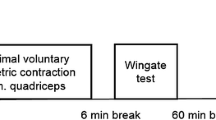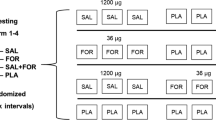Abstract
This study aimed to clarify the controversial effects of acute and short-term salbutamol (SAL) intake on sprint performance in healthy athletes. Based on the results of previous studies, an anabolic effect for the short-term treatment and increased glycolysis in both treatments were hypothesized. Eight male recreational athletes completed force–velocity exercise tests after administration of placebo (gelatin), acute oral SAL (6 mg) or short-term oral SAL (12 mg day−1 for 3 weeks), using a double-blind and randomized protocol. A friction-loaded cycle ergometer fitted with a strain gauge, and an incremental encoder ensured accurate measurement of the force–velocity relationship during sprints. Mechanical data were averaged during each pedal downstroke. Compared with placebo after both acute and 3 weeks of continuous treatment, the force–velocity relationship shifted to the right with power output gains of 14 and 8% (p < 0.001), respectively. This effect was less marked for 3 weeks of continuous treatment compared with acute administration (p < 0.001), suggesting a down-regulation in adrenoceptors. Our first hypothesis thus seems rejected. Significantly higher end-of-exercise and recovery blood lactate concentrations were found under SAL compared with placebo (p < 0.001), supporting our second hypothesis. In conclusion, these data indicate that oral administration of SAL is an effective ergogenic aid for sprint exercise in non-asthmatic athletes. Moreover, an acute treatment seems to be more effective than 3 weeks of continuous treatment.




Similar content being viewed by others
References
Arsac LM, Belli A, Lacour JR (1996) Muscle function during brief maximal exercise: accurate measurements on a friction-loaded cycle ergometer. Eur J Appl Physiol Occup Physiol 74:100–106
Bangsbo J, Gollnick PD, Graham TE, Juel C, Kiens B, Mizuno M, Saltin B (1990) Anaerobic energy production and O2 deficit-debt relationship during exhaustive exercise in humans. J Physiol 422:539–559
Butler J, Kelly JG, O’Malley K, Pidgeon F (1983) Beta-adrenoceptor adaptation to acute exercise. J Physiol 344:113–117
Carter WJ, Lynch ME (1994) Comparison of the effects of salbutamol and clenbuterol on skeletal muscle mass and carcass composition in senescent rats. Metabolism 43:1119–1125
Caruso JF, Signorile JF, Perry AC, Leblanc B, Williams R, Clark M, Bamman MM (1995) The effects of albuterol and isokinetic exercise on the quadriceps muscle group. Med Sci Sports Exerc 27:1471–1476
Cepero M, Perez-Pertejo Y, Cubria JC, Reguera R, Balana-Fouce R, Ordonez C, Ordonez Escudero D (2000) Muscle and serum changes with salbutamol administration in aerobically exercised rats. Comp Biochem Physiol C Toxicol Pharmacol 126:45–51
Collomp K, Candau R, Millet G, Mucci P, Borrani F, Prefaut C, De Ceaurriz J (2002) Effects of salbutamol and caffeine ingestion on exercise metabolism and performance. Int J Sports Med 23:549–554
Collomp K, Le Panse B, Portier H, Lecoq AM, Jaffre C, Beaupied H, Richard O, Benhamou L, Courteix D, De Ceaurriz J (2005) Effects of acute salbutamol intake during a Wingate test. Int J Sports Med 26:513–517
Crivelli G, Millet GP, Gremion G, Borrani F (2011) Effects of salbutamol on the contractile properties of human skeletal muscle before and after fatigue. Acta Physiol (Oxf) 203(2):311–320
Hautier CA, Linossier MT, Belli A, Lacour JR, Arsac LM (1996) Optimal velocity for maximal power production in non-isokinetic cycling is related to muscle fibre type composition. Eur J Appl Physiol Occup Physiol 74:114–118
He ZH, Bottinelli R, Pellegrino MA, Ferenczi MA, Reggiani C (2000) ATP consumption and efficiency of human single muscle fibers with different myosin isoform composition. Biophys J 79:945–961
Hill AV (1938) The heat of shortening and the dynamic constants of muscle. Proc R Soc London 126:136–195
Hirvonen J, Rehunen S, Rusko H, Harkonen M (1987) Breakdown of high-energy phosphate compounds and lactate accumulation during short supramaximal exercise. Eur J Appl Physiol Occup Physiol 56:253–259
Lakomy HK (1986) Measurement of work and power output using friction-loaded cycle ergometers. Ergonomics 29:509–517
Le Panse B, Collomp K, Portier H, Lecoq AM, Jaffre C, Beaupied H, Richard O, Benhamou L, De Ceaurriz J, Courteix D (2005) Effects of short-term salbutamol ingestion during a Wingate test. Int J Sports Med 26:518–523
Le Panse B, Arlettaz A, Portier H, Lecoq AM, De Ceaurriz J, Collomp K (2007) Effects of acute salbutamol intake during supramaximal exercise in women. Br J Sports Med 41:430–434
Lemmer JT, Fleck SJ, Wallach JM, Fox S, Burke ER, Kearney JT, Storms WW (1995) The effects of albuterol on power output in non-asthmatic athletes. Int J Sports Med 16:243–249
Linossier MT, Denis C, Dormois D, Geyssant A, Lacour JR (1993) Ergometric and metabolic adaptation to a 5-s sprint training programme. Eur J Appl Physiol Occup Physiol 67:408–414
Martineau L, Horan MA, Rothwell NJ, Little RA (1992) Salbutamol, a beta 2-adrenoceptor agonist, increases skeletal muscle strength in young men. Clin Sci (Lond) 83:615–621
Meeuwisse WH, McKenzie DC, Hopkins SR, Road JD (1992) The effect of salbutamol on performance in elite nonasthmatic athletes. Med Sci Sports Exerc 24:1161–1166
Moore NG, Pegg GG, Sillence MN (1994) Anabolic effects of the beta 2-adrenoceptor agonist salmeterol are dependent on route of administration. Am J Physiol 267:E475–E484
Morton AR, Papalia SM, Fitch KD (1993) Changes in anaerobic power and strength performance after inhalation of Salbutamol in nonasthmatic athletes. Clin J Sport Med 3:14–19
Murphy RJ, Beliveau L, Seburn KL, Gardiner PF (1996) Clenbuterol has a greater influence on untrained than on previously trained skeletal muscle in rats. Eur J Appl Physiol Occup Physiol 73:304–310
Powell ML, Weisberger M, Gural R, Chung M, Patrick JE, Radwanski E, Symchowicz SS (1985) Comparative bioavailability and pharmacokinetics of three formulations of albuterol. J Pharm Sci 74:217–219
Prakash YS, van der Heijden HF, Gallant EM, Sieck GC (1999) Effect of beta-adrenoceptor activation on [Ca2+]i regulation in murine skeletal myotubes. Am J Physiol 276:C1038–C1045
Ryall JG, Sillence MN, Lynch GS (2006) Systemic administration of beta2-adrenoceptor agonists, formoterol and salmeterol, elicit skeletal muscle hypertrophy in rats at micromolar doses. Br J Pharmacol 147:587–595
van Baak MA, Mayer LH, Kempinski RE, Hartgens F (2000) Effect of salbutamol on muscle strength and endurance performance in nonasthmatic men. Med Sci Sports Exerc 32:1300–1306
van Baak MA, de Hon OM, Hartgens F, Kuipers H (2004) Inhaled salbutamol and endurance cycling performance in non-asthmatic athletes. Int J Sports Med 25:533–538
Voet D, Voet J (1998) Biochimie Paris Bruxelles De Boeck université 507–512
Weiler JM, Layton T, Hunt M (1998) Asthma in United States Olympic athletes who participated in the 1996 summer games. J Allergy Clin Immunol 102:722–726
Acknowledgments
The authors wish to thank the subjects for their dedicated performance, Jean-Philippe Daguerre for his technical assistance and Catherine Carmeni for revising the English manuscript. In addition, the authors wish to thank Glaxo-Wellcome of Evreux, France, for providing the salbutamol medication as well as the staff of the Recherche Clinique at Hospital Arnaud de Villeneuve in Montpellier for their assistance.
Conflict of interest
The authors declare no conflict of interest.
Author information
Authors and Affiliations
Corresponding author
Additional information
Communicated by Susan A. Ward.
Rights and permissions
About this article
Cite this article
Sanchez, A.M.J., Collomp, K., Carra, J. et al. Effect of acute and short-term oral salbutamol treatments on maximal power output in non-asthmatic athletes. Eur J Appl Physiol 112, 3251–3258 (2012). https://doi.org/10.1007/s00421-011-2307-3
Received:
Accepted:
Published:
Issue Date:
DOI: https://doi.org/10.1007/s00421-011-2307-3




